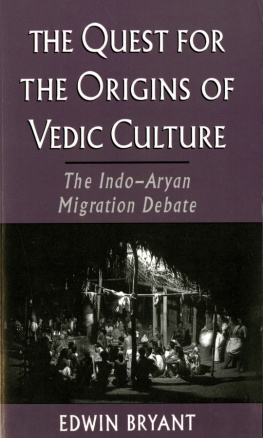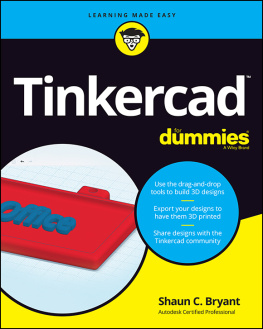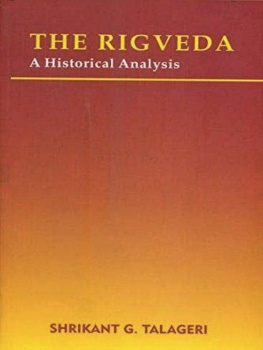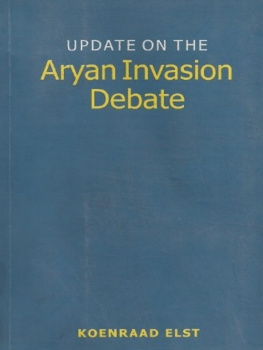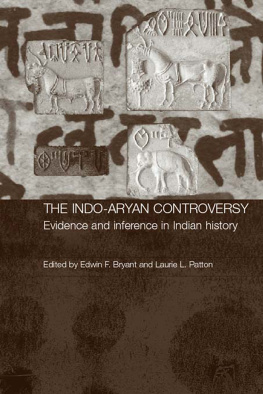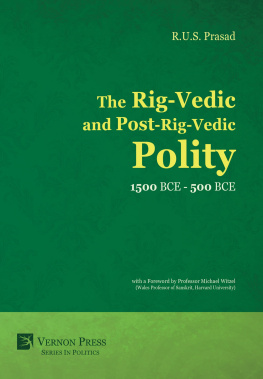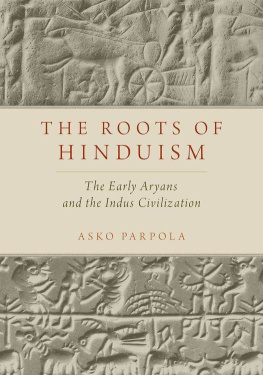Bryant - The In quest of the origins of Vedic culture: the Indo-Aryan migration debate
Here you can read online Bryant - The In quest of the origins of Vedic culture: the Indo-Aryan migration debate full text of the book (entire story) in english for free. Download pdf and epub, get meaning, cover and reviews about this ebook. City: New York;India, year: 2000;2015, publisher: Oxford University Press USA - OSO, genre: Home and family. Description of the work, (preface) as well as reviews are available. Best literature library LitArk.com created for fans of good reading and offers a wide selection of genres:
Romance novel
Science fiction
Adventure
Detective
Science
History
Home and family
Prose
Art
Politics
Computer
Non-fiction
Religion
Business
Children
Humor
Choose a favorite category and find really read worthwhile books. Enjoy immersion in the world of imagination, feel the emotions of the characters or learn something new for yourself, make an fascinating discovery.
- Book:The In quest of the origins of Vedic culture: the Indo-Aryan migration debate
- Author:
- Publisher:Oxford University Press USA - OSO
- Genre:
- Year:2000;2015
- City:New York;India
- Rating:5 / 5
- Favourites:Add to favourites
- Your mark:
- 100
- 1
- 2
- 3
- 4
- 5
The In quest of the origins of Vedic culture: the Indo-Aryan migration debate: summary, description and annotation
We offer to read an annotation, description, summary or preface (depends on what the author of the book "The In quest of the origins of Vedic culture: the Indo-Aryan migration debate" wrote himself). If you haven't found the necessary information about the book — write in the comments, we will try to find it.
The In quest of the origins of Vedic culture: the Indo-Aryan migration debate — read online for free the complete book (whole text) full work
Below is the text of the book, divided by pages. System saving the place of the last page read, allows you to conveniently read the book "The In quest of the origins of Vedic culture: the Indo-Aryan migration debate" online for free, without having to search again every time where you left off. Put a bookmark, and you can go to the page where you finished reading at any time.
Font size:
Interval:
Bookmark:

The Quest for the Origins of Vedic Culture
The Quest for the Origins of Vedic Culture
The Indo-Aryan Migration Debate
EDWIN BRYANT

2001

Oxford New York
Athens Auckland Bangkok Bogot Bombay Buenos Aires Cape Town
Chennai Dar es Salaam Delhi Florence Hong Kong Istanbul Karachi
Kolkata Kuala Lumpur Madrid Melbourne Mexico City Mumbai
Nairobi Paris So Paulo Shanghai Singapore Taipei Tokyo Toronto Warsaw
and associated companies
in Berlin Ibadan
Copyright 2001 by Edwin Bryant
Published by Oxford University Press, Inc.
198 Madison Avenue, New York, New York 10016
Oxford is a registered trademark of Oxford University Press
All rights reserved. No part of this publication may be reproduced, stored in a retrieval system, or transmitted, in any form or by any means, electronic, mechanical photocopying, recording, or otherwise, without the prior permission of Oxford University Press.
Library of Congress Cataloging-in-Publication Data
Bryant, Edwin
The quest for the origins of Vedic culture:
the Indo-Aryan migration debate / Edwin Bryant.
p. cm.
Includes bibliographical reference and index.
ISBN 0-19-513777-9; ISBN 0-19-516947-6 (PBK)
ebook ISBN 978-0-19-988133-8
1. Indo-AryansOrigin. 2. IndiaHistoryTo 324 B.C. 3. Indus civilization I. Title.
DS425.B79 2000
934.02dc21 99-086274
First published as an Oxford University Press paperback 2003
1 3 5 7 9 8 6 4 2
Printed in the United States of America on acid-free paper
To my father and sister
for all their support.
And to Fran, Ted, and Jack
for making this possible.
To Fran Pritchet, for taking me under her wing right from the start; Ted Riccardi, for always encouraging me to pursue my intellectual interests; and Jack Hawley, for making sure that I came up to standard. To Gary Tubb, for his comments, meticulous as always, and to Michael Witzel, for being so generous with his time and vast learning. To James Mallory, for extensive comments, and to Kim Plofker, for valuable criticisms. To Richard Meadow, Hans H. Hock, Hermut Scharfe, Peter Rahul Das, Jay Jasanoff, and Thomas Trautmann for providing feedback on various chapters or sections of this work. To Fred Smith, Carl Lamberg-Karlovsky, and Vasudha Narayanan for their help. To the many scholars whom I had the good fortune to meet in India, and who were so generous with their time and hospitality. Needless to say, the views represented herein are my own and not necessarily of those who have been kind enough to point out the most egregious errors in previous drafts of this work. Special thanks to Matthew Ekstrand-Abueg for doing a great job with the maps and diagrams despite the last-minute time constraints, and to Martin von Wyss from the Harvard map room; to Fritz Staal for his assistance in obtaining the photograph for the cover; to Pia Bryant for her extensive editing; to the American Institute of Indian Studies for providing me with a research and travel grant, and to the Charlotte Newcombe Foundation for offering me a Ph.D write-up grant.
The solution to the Indo-European problem has been one of the most consuming intellectual projects of the last two centuries. It has captivated the imagination and dedication of generations of archaeologists, linguists, philologists, anthropologists, historians, and all manner of scholarly, and not so scholarly, dilettantes. Predicated on the deduction that cognate languages necessitate an original protoform spoken by a group of people inhabiting a reasonably delineated geographic area, the problem has resulted in a massive amount of scholarship attempting to reconstruct this protolanguage, locate the original homeland where it was spoken, and conjecture on the social and cultural life of the protospeakers. Although the endeavor has very much been a preoccupation of European scholars, the belief in and pursuit of the origins of European civilization have required scholars to attempt to reconstruct and reconfigure the prehistory and protohistories of other civilizations whose languages happen to belong to the Indo-European language family.
The publicization, in Europe, of the Sanskrit language and of its connection with the classical languages of Europe was the catalyst for the whole post-Enlightenment quest for the Indo-Europeans that continues, unresolved, to this day. This discovery of Sanskrit resulted in the earliest history of the Indian subcontinent also being subsumed by the problem of European origins. Although India was initially entertained as the homeland of all the Indo-Europeans, various arguments were raised against this proposal, and Indian civilization was construed as the joint product of an invading Indo-European peoplethe Indo-Aryan branch of the familyand indigenous non-Indo-European peoples. Yet although taking it upon themselves to determine the history of the Indian subcontinent in accordance with the currents of scholarship that have ebbed and flowed in academic circles in Europe over the decades, Western scholars have generally been unaware, or dismissive, of voices from India itself that have been critical over the years of this European reconstruction of their countrys history. In the words of one of the scholars who will be featured here, However well-meaning such [scholars] and their publications are, they have taken it upon themselves the task of interpreting the past heritage of a very large number of people who belong to various nation states and may like to formulate their own ideas of the past (Chakrabarti 1997, 207).
This book is primarily a historiographical study of how various Indian scholars, over the course of a century or more, have rejected this idea of an external origin of the Indo-Aryans by questioning much of the logic, assumptions, and methods upon which the theory is based. The aim of the book is threefold. A primary aim is to excavate marginalized points of view reacting against what is perceived as a flawed and biased historical construct. As a corollary of this aim, this work will further complicate the Indo-European homeland quest by exposing the whole endeavor to a critique from scholars outside mainstream European academic circles who do not share the same intellectual history as their Western peers. A further aim of this book is to present a comprehensive exposition and analysis of views from within mainstream academic circles addressing the issue of Indo-Aryan origins.
With regard to the primary aim, I have used the term Indigenous Aryanism to denote a theme that is common to many of the scholars I examine in this book. This runs the risk of essentializing a quite variegated cast of characters, and I merely use the term to encompass a position on Indian protohistory that I view as common to most of the arguments that I examine. The scholars referred to by this term all share a conviction that the theory of an external origin of the Indo-Aryan speaking people on the Indian subcontinent has been constructed on flimsy or false assumptions and conjectures. As far as such scholars are concerned, no compelling evidence has yet been produced to posit an external origin of the Indo-Aryans.
The various scholars whose work I have examined here are a disparate group. They range from brilliant intellectuals like Aurobindo, to professional scholars like B. B. Lai, to what most academics would consider crackpots, like P. N. Oak. The primary feature they share is that they have taken it upon themselves to oppose the theory of Aryan invasions and migrationshence the label
Font size:
Interval:
Bookmark:
Similar books «The In quest of the origins of Vedic culture: the Indo-Aryan migration debate»
Look at similar books to The In quest of the origins of Vedic culture: the Indo-Aryan migration debate. We have selected literature similar in name and meaning in the hope of providing readers with more options to find new, interesting, not yet read works.
Discussion, reviews of the book The In quest of the origins of Vedic culture: the Indo-Aryan migration debate and just readers' own opinions. Leave your comments, write what you think about the work, its meaning or the main characters. Specify what exactly you liked and what you didn't like, and why you think so.

